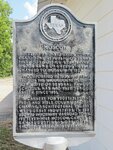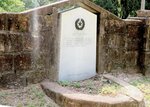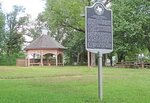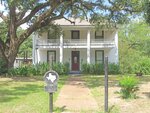







Who would have ever thought there would be a town in rural East Texas named Moscow? But just down the road from Livingston, Texas at the junction of U.S. Highway 59 and Farm to Market Road 350 is the tiny, peaceful unincorporated town of Moscow, Texas. At first sight, there is not much to suggest a stop there – possibly a small convenience store/gas station and post office. Blink and you’ll miss this community of 170 residents (according to the 2000 census). But look just a little past the end of your nose – Moscow, Texas exudes history. In fact, within a four-block radius there are two city parks and – count them – five Texas historical markers. Just four miles beyond them on FM 350 is another, most intriguing, Texas historical marker. Oh, the stories this little town could tell if it could speak. Take the time to read the markers and an unexpected prosperous past emerges out of history’s midst.
The first marker tells a story, one how Moscow came into being, and begins the revelation of the forgotten saga. David and Matilda Green settled on the John Dickinson headright in the 1840s during the era of the Republic of Texas. Green established a post office in 1847 calling this place simply, Green’s. However, the name of this community changed to Moscow, Texas in 1853 when the postal authorities rejected the proposed formal name of Greenville – it was too close to another town, Greensboro, Texas. In frustration, the folks then named it after a city they knew was nowhere close to the name or their location – Moscow, Russia – and the postal authorities were happy.
Moscow was originally incorporated in 1856 and sometime in the late 1800s became a trading center for farmers and a stage stop on the Liberty-Nacogdoches Road. In 1880, with a citizenship of 228 people, it became the largest city in Polk County. In its heyday, it boasted cotton gins, sawmills, saloons, a hotel, a food cannery and an architectural column factory among other businesses and shops. And the railroads came: the Houston, East and West Texas Railway (1880); followed by the seven-mile-long Moscow, Camden and San Augustine constructed from Moscow to Camden in 1899 (one of the shortest railroads in Texas). They were so “uptown” then, that a mule-drawn streetcar transported people from the business district to the railroad depot. A weekly newspaper, the East Texas Pinery, was first published in Moscow in 1885.
A second marker tells the story of the First Baptist Church. It states the church was built in 1849 by members utilizing square nails, hand sawn lumber, and pegs joining sills and floor framing. This marker was recorded in 1945 prior to Texas’ Centennial year celebration. The marker resides on the outside wall of a little church. Today’s First Baptist Church looks very different from the one described in the historical marker.
A third marker appears outside a well-manicured antebellum house – the E.C. Mathews house. This house was built in 1856 by “Daddy Poe.” It incorporates columns made of hollowed pine trees (a process Poe pioneered) and a swinging upstairs porch. In the peak of its success, Moscow featured a factory that made the hollow columns from the area’s large pine trees.
The fourth and fifth historical markers are located on the two city parks mentioned earlier. One marker and park commemorate Texas Statesman William Pettus Hobby, and the other marker and city park memorializes the Moscow Male and Female Academy (operated after 1857 under Masonic authorization as the Moscow Masonic Academy) which is how it is basically remembered. Both parks seem to be under utilized and have seen better days but would make good places for a picnic lunch on a road trip discovering Moscow.
The marker for William Pettus Hobby (1878-1964), businessman and politician, states he was born near the marker’s site in Moscow, Texas. He attended the Masonic Moscow Academy. In 1895, he began work at The Houston Post as a circulation clerk. He became the Post’s managing editor at the age of 23 and was named publisher of The Beaumont Enterprise in 1907. He became the governor of Texas in 1917 when James E. Ferguson was impeached and was elected to his own full term in 1919. He was the president of the Houston Post from 1924 until his death in 1964. The Houston Post Company included both the radio station KPRC and KPRC-TV. In August 1955, he became chairman of the board of the company. The state historical marker at his birthplace was dedicated in Moscow in 1964.
The Moscow (Masonic) Male and Female Academy marker was erected in 1963 and positioned in the remains of what was the wall surrounding the school. The marker is included in the Texas 1936 Centennial Markers and Monuments list. The Moscow Male and Female Academy was built in 1853 and served the community under this name until 1857 when the Masons took the school under their auspices and it became the Moscow Masonic Academy (or according to some sources, Moscow Masonic High School). The school remained in Masonic hands until it merged into the public school system. In Moscow’s glory days, it was “the place” to send your children to be educated. Many dignitaries attended this school. The school burned down around 1935 and there is little left on the grounds but a couple of original staircases and a partial wall.
The most intriguing state marker is about four miles out FM 350 in front of the Holhausen Darby Cemetery (established 1862) – that for John Wesley Hardin (May 26, 1853 – August 19, 1895), the western outlaw and gunslinger. The marker indicates that it is placed near the boyhood home of Hardin, that he was a folk hero and an ardent Southerner who killed over 30 men in his life. It goes on to say that his resistance to Union troops made him a hero and set him on his lawless career. His family was politically active and well connected in the Confederacy, with his father achieving the rank of captain. Hardin even ran away from home in1862 at the age of nine to join the Confederacy. Hardin reached adolescence and was strongly against black people as the South entered the Reconstruction period.
Hardin was living in or around Moscow when in November 1868 at age 15, he challenged his Uncle Holhousen’s former slave, Major “Maje” Holhausen, to a wrestling match – which Hardin won. On the next day – according to Hardin – “Maje” ambushed him, and Hardin shot him five times. “Maje” died three days later. Hardin’s father believed he would not receive a fair trial in a Union-occupied state (where more than a third of the state police were former slaves) and ordered his son into hiding. Weeks later, three Union soldiers were sent to arrest Hardin. Hardin shot and killed them. So, Moscow was the site of John Wesley Hardin’s first victim on the road to his killing over 30 men. Who knew?
There are three other markers a little further from Hardin’s marker outside of Moscow: the town of Corrigan (7.2 miles away); Bethel Baptist Church (approximately. 7½ miles away); and Greenfield Cemetery (approximately 13.1 miles away). There’s a lot of history packed into the area around Moscow that you might miss if you blink when you drive by. So, on a cool Autum day, grab your camera, pack a picnic lunch and take a road trip to Moscow … Texas. You might just learn something. I know I did. n